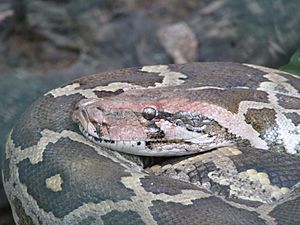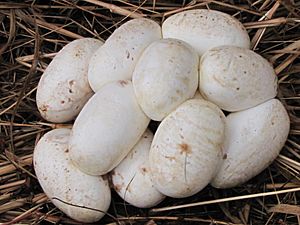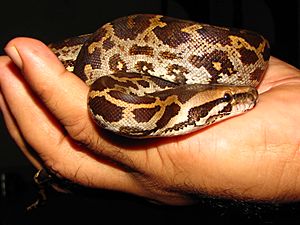Python molurus facts for kids
Quick facts for kids Python molurus |
|
|---|---|
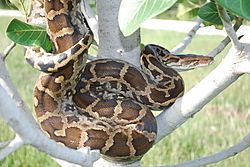 |
|
| Near Nagarhole National Park | |
| Conservation status | |
| Scientific classification | |
| Kingdom: | |
| Subphylum: | |
| Class: | |
| Order: | |
| Suborder: | |
| Family: | |
| Genus: | |
| Binomial name | |
| Python molurus (Linnaeus, 1758)
|
|
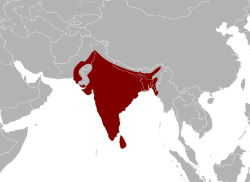 |
|
| Distribution of Indian python | |
The Indian python (scientific name: Python molurus) is a very large snake. It is not venomous, meaning it does not have poison. This amazing snake lives in warm, tropical and subtropical parts of South Asia and Southeast Asia.
People also call it the black-tailed python or Indian rock python. It is usually lighter in color than its cousin, the Burmese python. These powerful snakes can grow up to about 3 meters (10 feet) long!
Indian pythons have a beautiful pattern of blotches on their skin. Their main color can be whitish or yellowish. The blotches can be different shades, from light tan to dark brown. The colors often match the area where the snake lives. For example, pythons from hilly forests might be darker. Those from flat plains might be lighter.
The longest Indian python ever recorded was found in Pakistan. It was about 4.6 meters (15 feet) long and weighed 52 kilograms (115 pounds). That's like a small car!
Contents
What Does the Indian Python Look Like?
The Indian rock python has a whitish or yellowish body with blotchy patterns. These patterns can range from tan to dark brown. The colors change depending on the land and where the snake lives. Snakes from the hill forests of the Western Ghats and Assam are often darker. Those from the Deccan Plateau and the eastern coast of India are usually lighter.
In India, these pythons typically grow to about 3 meters (10 feet) long. A study in Keoladeo National Park found that many pythons were between 2.7 and 3.3 meters long. Some even reached almost 3.6 meters (12 feet)!
It can be hard to know the exact maximum length of this snake. This is because people sometimes confused it with the Burmese python in the past. Also, some measurements came from stretched skins, which made them seem longer. The longest one ever officially recorded was 4.6 meters (15 feet) long and weighed 52 kilograms (115 pounds). In Pakistan, Indian pythons often grow to be 2.4 to 3 meters (8 to 10 feet) long.
Where Do Indian Pythons Live?
The Indian python lives in many countries in Asia. You can find them in India, southern Nepal, Pakistan, Sri Lanka, Bhutan, Bangladesh, and possibly northern Myanmar.
These snakes live in many different places. They can be found in grassy areas, swamps, marshes, and rocky hills. They also live in woodlands, open forests, and river valleys. Indian pythons always need a place with water nearby. They like to hide in old burrows made by other animals. They also hide in hollow trees, thick water plants, and mangrove forests.
How Do Indian Pythons Behave?
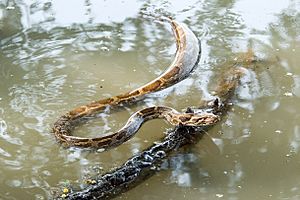
Indian pythons are usually slow and calm. They are also quite shy and rarely attack, even if they are bothered. They usually move in a straight line, by "walking on their ribs."
These snakes are excellent swimmers and feel very comfortable in water. They can stay completely underwater for several minutes if they need to. However, they usually prefer to stay close to the river or lake bank.
What Do Indian Pythons Eat?
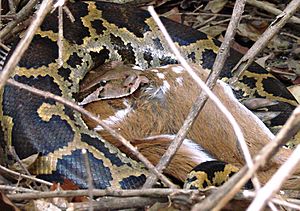
Like all snakes, Indian pythons are carnivores, meaning they only eat meat. They hunt and eat mammals, birds, and even other reptiles. However, they seem to prefer eating mammals.
When a python sees its prey, it becomes active. It moves forward with its tail shaking and lunges with its mouth open. The snake then wraps its body around the live animal, squeezing it tightly. The prey cannot breathe and dies. After that, the python swallows the prey head first.
After a big meal, pythons do not like to move. If they are forced to move, the hard parts of their meal could hurt them. So, if disturbed, some pythons might spit out their meal to escape from danger. After a very large meal, a python might not eat for many weeks. The longest time recorded was two years! Pythons can swallow prey that is bigger than their own head. This is because their jaw bones are not connected. Also, their teeth point backward, like a saw, so prey cannot escape once caught.
Indian Python Reproduction and Life Cycle
Indian pythons lay eggs. A female python can lay up to 100 eggs at one time. She protects and keeps her eggs warm. To do this, she can even make her body temperature higher than the air around her by twitching her muscles.
When the baby pythons hatch, they are about 45 to 60 centimeters (18 to 24 inches) long. They grow very quickly! Scientists in India have even found ways to help abandoned eggs hatch using special warm chambers.
Images for kids
See also
 In Spanish: Pitón de la India para niños
In Spanish: Pitón de la India para niños




